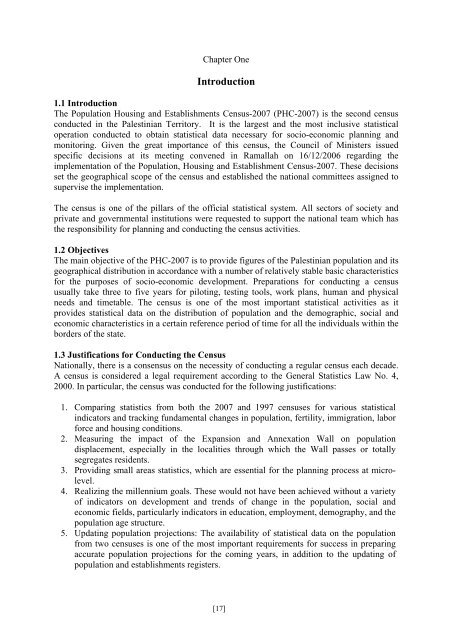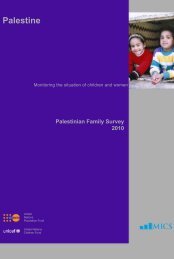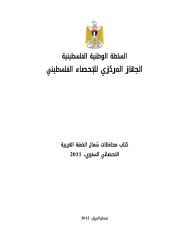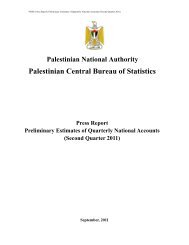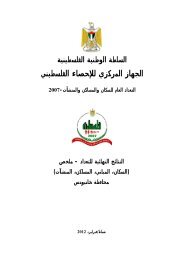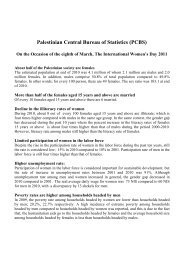اÙÙتائج اÙÙÙائÙØ© ÙÙتعداد ÙÙ Ùطاع غزة Ù Ùخص - Palestinian Central ...
اÙÙتائج اÙÙÙائÙØ© ÙÙتعداد ÙÙ Ùطاع غزة Ù Ùخص - Palestinian Central ...
اÙÙتائج اÙÙÙائÙØ© ÙÙتعداد ÙÙ Ùطاع غزة Ù Ùخص - Palestinian Central ...
Create successful ePaper yourself
Turn your PDF publications into a flip-book with our unique Google optimized e-Paper software.
Chapter One<br />
Introduction<br />
1.1 Introduction<br />
The Population Housing and Establishments Census-2007 (PHC-2007) is the second census<br />
conducted in the <strong>Palestinian</strong> Territory. It is the largest and the most inclusive statistical<br />
operation conducted to obtain statistical data necessary for socio-economic planning and<br />
monitoring. Given the great importance of this census, the Council of Ministers issued<br />
specific decisions at its meeting convened in Ramallah on 16/12/2006 regarding the<br />
implementation of the Population, Housing and Establishment Census-2007. These decisions<br />
set the geographical scope of the census and established the national committees assigned to<br />
supervise the implementation.<br />
The census is one of the pillars of the official statistical system. All sectors of society and<br />
private and governmental institutions were requested to support the national team which has<br />
the responsibility for planning and conducting the census activities.<br />
1.2 Objectives<br />
The main objective of the PHC-2007 is to provide figures of the <strong>Palestinian</strong> population and its<br />
geographical distribution in accordance with a number of relatively stable basic characteristics<br />
for the purposes of socio-economic development. Preparations for conducting a census<br />
usually take three to five years for piloting, testing tools, work plans, human and physical<br />
needs and timetable. The census is one of the most important statistical activities as it<br />
provides statistical data on the distribution of population and the demographic, social and<br />
economic characteristics in a certain reference period of time for all the individuals within the<br />
borders of the state.<br />
1.3 Justifications for Conducting the Census<br />
Nationally, there is a consensus on the necessity of conducting a regular census each decade.<br />
A census is considered a legal requirement according to the General Statistics Law No. 4,<br />
2000. In particular, the census was conducted for the following justifications:<br />
1. Comparing statistics from both the 2007 and 1997 censuses for various statistical<br />
indicators and tracking fundamental changes in population, fertility, immigration, labor<br />
force and housing conditions.<br />
2. Measuring the impact of the Expansion and Annexation Wall on population<br />
displacement, especially in the localities through which the Wall passes or totally<br />
segregates residents.<br />
3. Providing small areas statistics, which are essential for the planning process at microlevel.<br />
4. Realizing the millennium goals. These would not have been achieved without a variety<br />
of indicators on development and trends of change in the population, social and<br />
economic fields, particularly indicators in education, employment, demography, and the<br />
population age structure.<br />
5. Updating population projections: The availability of statistical data on the population<br />
from two censuses is one of the most important requirements for success in preparing<br />
accurate population projections for the coming years, in addition to the updating of<br />
population and establishments registers.<br />
[17]


